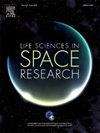2024年1 - 10月太阳粒子事件期间TGO火星轨道辐射环境相应的太阳爆发和GOES质子通量数据
IF 2.8
3区 生物学
Q2 ASTRONOMY & ASTROPHYSICS
引用次数: 0
摘要
用于测量ExoMars微量气体轨道器(TGO)上辐射环境的剂量计liolin - mo是精细分辨率超热中子探测器(FREND)的一个模块。从2021年7月到2024年7月,在火星轨道上观测到许多太阳高能粒子(SEP)事件,在第25太阳周期活动的增加阶段接近最大值。liolin - mo在2021-2023年获得的SEPs测量结果之前已经报道过。本文介绍了对2024年1 - 10月SEP事件辐射参数的观测结果。迄今为止在TGO轨道上记录到的最强大的SEP事件始于2024年5月20日。本次SEP事件的最大剂量率为2800±280µGy h-1,最大粒子通量为383±19 cm-2 s-1。整个事件持续约64小时,直至5月24日,并有剂量率和通量增加的长尾。SEP事件主期64小时的总剂量为24.7±2.5 mGy。在太阳活动周期25的这一阶段,太阳辐射的总剂量相当于200天内接收到的银河宇宙射线(GCR)的剂量。2024年1月至9月期间来自所有sep的总剂量为36.6 mGy (Si),与同期来自GCR的剂量大致相等。将火星轨道上的sep观测结果与地球轨道上GOES卫星在同一时期测量的质子通量进行了比较。结果表明,除了5月20日至24日和9月05日至7日最大的SEP事件外,在火星轨道上观测到的一些SEP事件也可以在GOES质子通量数据中看到。在火星和地球轨道上记录的SEP事件与SOHO和STEREO A日冕仪观测到的日冕物质抛射(cme)有关。本文表明,无论是在柳林- mo数据中,还是在GOES质子通量数据中,大部分SEP事件都是光环日冕物质抛射事件。这篇论文还表明,在火星轨道上发生的三次最强烈的SEP事件——5月20日、7月23日和9月5日——都是来自太阳背面的日冕物质抛射。其中一些日冕物质抛射与主要的X级远端耀斑有关。对火星轨道上GCRs辐射参数的长期研究表明,2024年8月(我们没有记录SEP事件的数据的最后一个月)的剂量率为6.5±0.65µGy h-1,粒子通量为- 1.4±0.07 cm-2 s-1。这些值约为2020年3月柳林- mo在第24太阳周期极小值期间测量到的相应最大值的40%。以上结果显示了长期测量(至少在一个完整的太阳活动周期内)火星附近辐射状况的重要性。这种测量将有可能获得规划未来载人和机器人飞行任务所需的数据,以及在太阳活动周期中选择载人飞往地球的最佳时间间隔。本文章由计算机程序翻译,如有差异,请以英文原文为准。
Radiation environment on TGO Mars orbit during solar particle events in January–October 2024. Corresponding solar eruptions and GOES proton fluxes data
The dosimeter Liulin-MO for measuring the radiation environment on board the ExoMars Trace Gas Orbiter (TGO) is a module in the Fine Resolution Epithermal Neutron Detector (FREND).
A number of solar energetic particle (SEP) events were observed in Mars orbit from July 2021 to 2024 during the increasing phase and close to the maximum of the 25th solar cycle activity. The results from the SEPs measurements obtained in 2021–2023 by Liulin-MO have been previously reported. Here we present the Liulin-MO results from the observation of the radiation parameters of the SEP events during January- October 2024. The most powerful SEP event registered up to now in TGO orbit started on 20 May 2024. The maximum dose rate during this SEP event has been 2800 ± 280 µGy h-1 and the maximum particle flux – 383 ± 19 cm-2 s-1. The total event lasted for about 64 hours up to 24 May with a long tail of increased dose rates and fluxes. The total dose from SEPs for the 64 hours of the main phase of the SEP event was 24.7 ± 2.5 mGy. The total dose from SEPs during this event is equal to the dose from the galactic cosmic rays (GCR) received for about 200 days at this phase of solar cycle 25. The total dose from all SEPs during January – September 2024 is 36.6 mGy (in Si), which is approximately equal to the dose received from GCR for the same period.
The observations of SEPs in Mars orbit are compared to the observations during the same periods of proton fluxes measured by the GOES satellite in Earth orbit. The results show that some of the SEPs observed in Mars orbit, excluding the biggest SEP events of 20-24 May and 05-07 September, are also seen in the GOES proton fluxes data. SEP events recorded both in Mars and Earth orbits are related to coronal mass ejections (CMEs) observed by the SOHO and STEREO A coronagraphs. The paper shows that responsible for most of the SEP events registered both in the Liulin-MO data and in the GOES proton fluxes data are halo CMEs. The paper also shows that the sources of the three most powerful SEP events in Mars orbit – those of 20 May, 23 July and 05 September – are halo CMEs from the far side of the Sun. Some of these CMEs are associated with major X class far-side flares.
Long-term investigations of the GCRs radiation parameters in Mars orbit show that in August 2024 (the last month of our data with no recorded SEP events) the dose rate was 6.5 ± 0.65 µGy h-1 and the particle flux – 1.4 ± 0.07 cm-2 s-1. These values are about 40 % of the corresponding maximal values measured by Liulin-MO during the solar cycle 24 minimum in March 2020.
The above results show the importance of long-term measurements (at least during a full solar cycle) of the radiation conditions in Mars vicinity. Such measurements will make it possible to obtain the data necessary for the planning of future manned and robotic missions, as well as for the selection of the best time interval in the solar cycle for a manned flight to the planet.
求助全文
通过发布文献求助,成功后即可免费获取论文全文。
去求助
来源期刊

Life Sciences in Space Research
Agricultural and Biological Sciences-Agricultural and Biological Sciences (miscellaneous)
CiteScore
5.30
自引率
8.00%
发文量
69
期刊介绍:
Life Sciences in Space Research publishes high quality original research and review articles in areas previously covered by the Life Sciences section of COSPAR''s other society journal Advances in Space Research.
Life Sciences in Space Research features an editorial team of top scientists in the space radiation field and guarantees a fast turnaround time from submission to editorial decision.
 求助内容:
求助内容: 应助结果提醒方式:
应助结果提醒方式:


